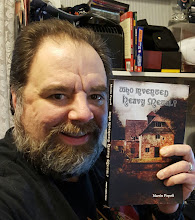
“I’m a Speed King, you go to hear me sing,
I’m a Speed King, see me fly.”
I’m a Speed King, see me fly.”
My Deep Purple fix was reached this week; as Martin Popoff sent me his latest book, The Deep Purple Royal Family. I decided to combine my review of it with Purple’s most important album, In Rock, from 1970.
When I first heard this thunderous clash thay was the distortion of sound that commanded attention from Deep Purple on the opening of “Speed King” from in Rock, I was taken aback. Then the song reaches a respite with the aid of Jon Lord’s keyboards—then we “hit it” with the Good Golly Miss Molly screeches from Ian Gillian and the song is under the command of the first truly metal band as this is the first truly metal album. Lord’s keyboards enhance the surreal as Ritchie Blackmore takes the guitar to a new level of controlled chaos and Ian Paice’s drums pound a relentless rhythm that drives home the sound. The true hero, on this album as well as this song, is Roger Glover as his bass soars. Not regulated to a background instrument, Glover’s bass gives the “drive” that IS heavy metal. Song after unrelentless song, Glover delivers.
Bloodsucker follows and is not the champion that Speed King is, but it strikes a harsh nerve. Again, it sounds as if Deep Purple is the absolute most important thing on the planet in this song, as the fever hits and the band delivers.
The sublime Child In Time follows, sublime, if only for a moment. The band breaks in some jazz infusion moments in this song until the pace quickens to Blackmore’s total control of the Stratocaster. Keeping us grounded the entire time is the fore-mentioned Roger Glover. Slightly after midway through this song, Jon Lord takes us back to a state of bliss, added to the controlled vocals of Gillian. Hang on metal fans, Ritchie shows us soon enough why he is the master.
Flight of the Rat continues the guitar power that Blackmore is capable of reaching. It sounds as if the producers put Gillian’s vocals in the background so Blackmore’s guitars and Paice’s drum will be the centerpiece. Notice the fills of Glover’s bass in this unheralded song. This bad boy thunders along quite nicely. Considered by many as a “throwaway” number, this song is proof that there is no such thing from a Deep Purple album at this time.
Into the Fire starts with a perfect blend of keyboards/bass/guitars in a moment of power until Gillian screams his articulate voice. I think this song, if no other, shows how incredible Ian Gillian truly is. This song is his showstopper. True Ritchie Blackmore riffs hard on this one, but Gillian stretches the vocal chords far and thin.
Living Wreck starts with Paice’s drumming talent, followed by Glover’s control. This is one song that comes off some highs from the first side, only to show the listener that this is a band, not a Blackmore/Gillian showpiece. Lord’s keyboards reach a new height of power on this track. Can the keyboards be a metal instrument? In the hands of Jon Lord, the answer is a resounding yes.
Hard Loving Man, starts off similar to Speed King with the crash crescendo, follow by the signature heavy metal guitar riff that I would argue Ritchie Blackmore created. This song also has the heavy metal scream often copied by groups like Judas Priest, as Gillian is nothing short of incredible on this track. This is the way to end an album.
Newer versions of this CD include the bonus track/single Black Night. Whereas it is a great song, it would not do justice to the hard rocking/metalesque pace of the other songs on In Rock.
Ok, I feel better getting that off of my chest.
Ok, I feel better getting that off of my chest.

Martin Popoff has written another great Deep Purple book called The Deep Purple Royal Family, which includes ads, concert bills, reviews, and all of the incredible tidbits of information surrounding the band. This first volume (and Martin says on his website that he will write a second volume covering the latter years) ends in 1979. The excitement for me was looking at all of the incredible pictures and historical documentation offered by Popoff to give the reader and music fan the complete picture of what the entire era was like. I have always enjoyed how Martin has included the posters/ads/ and collectable memorabilia of a group in his books, such as those shown In His Black Sabbath—Doom Let Loose; Judas Priest—Heavy Metal Painkillers, and Rush—Contents Under Pressure books. This collection goes way beyond what he has previously done. Buy this book at his site, http://www.martinpopoff.com/ and treat yourself to the complete picture which is Deep Purple.








